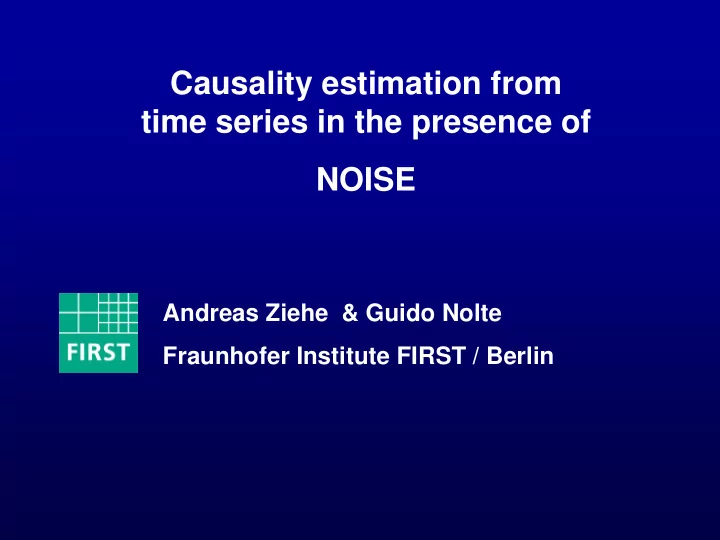

Causality estimation from time series in the presence of NOISE Andreas Ziehe & Guido Nolte Fraunhofer Institute FIRST / Berlin
Motivation • Many measurements like EEG/MEG/fMRI are extremely noisy Mixtures of independent sources: Additive noise: Do we estimate fake direction? Do we estimate wrong direction? Channel B Channel A Channel B Channel A Noise Source 2 Source 1 Noise2 Noise1
Granger causality ⎛ ⎞ E 1 E ⎜ ⎟ = x 1 F log E E 2 ⎜ ⎟ → y x ⎝ ⎠ 2 y = → − ˆ G F F → x y y x ˆ G G = ˆ std ( G )
Phase Slope Index C(f) (complex) coherence between two sensors ) ∑ Ψ = + δ * Im C ( f ) C ( f f ) f ) Ψ Ψ = ) ( Ψ std ) • ‘average’ phase slope • vanishes for mixtures of independent sources Nolte, et.al., Phys Rev Let., 2008
Simulated Challenge Data: signal + mixed noise − ξ ⎛ ⎞ ⎛ ⎞ ⎛ ⎞ ⎛ ⎞ x ( t ) 10 A ( p ) 0 x ( t p ) ( t ) Signal x i (t): ∑ ⎜ ⎟ ⎜ ⎟ ⎜ ⎟ ⎜ ⎟ = + 1 11 1 1 ⎜ ⎟ ⎜ ⎟ ⎜ ⎟ ⎜ ⎟ − ξ ⎝ ⎠ ⎝ ⎠ ⎝ ⎠ ⎝ ⎠ x ( t ) A ( p ) A ( p ) x ( t p ) ( t ) unidirectional = p 1 21 22 2 2 2 AR-Model ξ A ij p ( ) random, direction random, uniform i = ∑ 10 ~ Noise y i (t): : − + η y ( t ) A ( p ) y ( t p ) ( t ) i ii i i 3 independent sources = p 1 with random spectrum ~ η A ii p ( ) random, uniform i r r r x ( t ) B y ( t ) Data z i (t): : = − γ + γ z ( t ) ( 1 ) X BY Random superposition of signal and mixed noise × γ ∈ B random 2 3 matrix, random [ 0 , 1 ]
Simulated Challenge Data • 1000 examples, 6000 time points, 2 sensors • Task: estimate direction for all 1000 examples • Matlab code to generate examples is provided • Main idea: class of problems rather than specific problems Form of solutions: • True solutions: “x to y” or “y to x” • Possible answers: “x to y” or “y to x” or “I don’t know” How it is counted: • you get +1 for each correct, -10 for each wrong, 0 for each “I don’t know” • Main Idea: Evaluate evidence !!
Results for Granger Causality Correct wrong Total points 736 100 -264 wrong correct I don’t know correct wrong
Results for PSI Correct wrong Total points 638 6 578 wrong correct I don’t know correct wrong
Real Challenge Data Description: Features: • 10 subjects • strong „alpha rhythm“ • eyes closed at rest • direction of alpha rhythm ? • ≈ 10 minutes each • 256 Hz sampling rate • 19 sensors Power at 10 Hz
Results for PSI Matlab code to create figures is provided at http://ida.first.fraunhofer.de/~nolte/causality_challenge.html
Conclusion What matters: Simulated challenge data: • problem is generic (details are open to discussion) • evidence is weighted Real challenge data: • excellent data (thanks to Tom Brismar) • truth unknown
Thanks to Vadim Nikulin Stefan Haufe Nicole Krämer Alois Schlögl Tom Brismar Klaus-Robert Müller
Recommend
More recommend